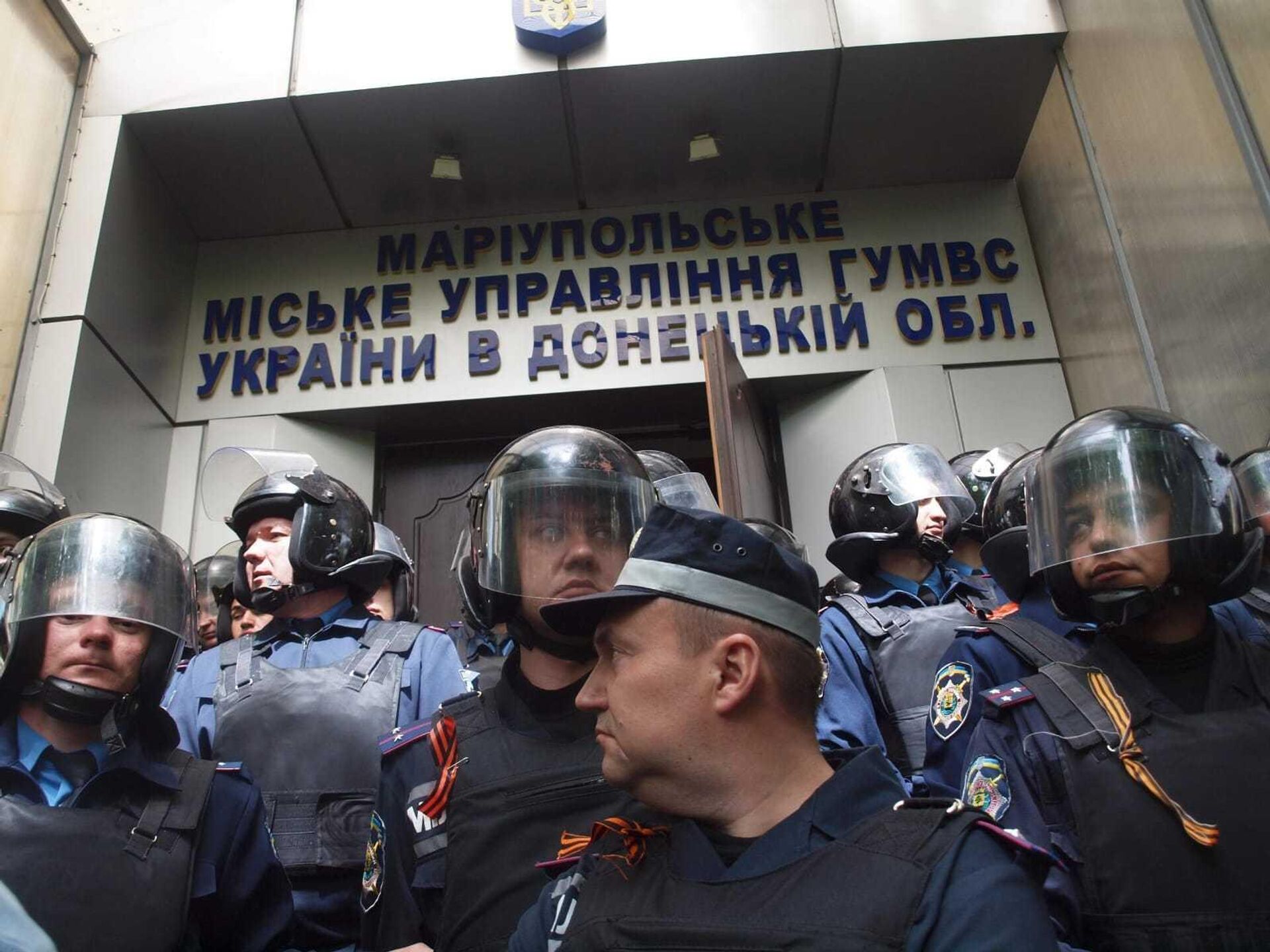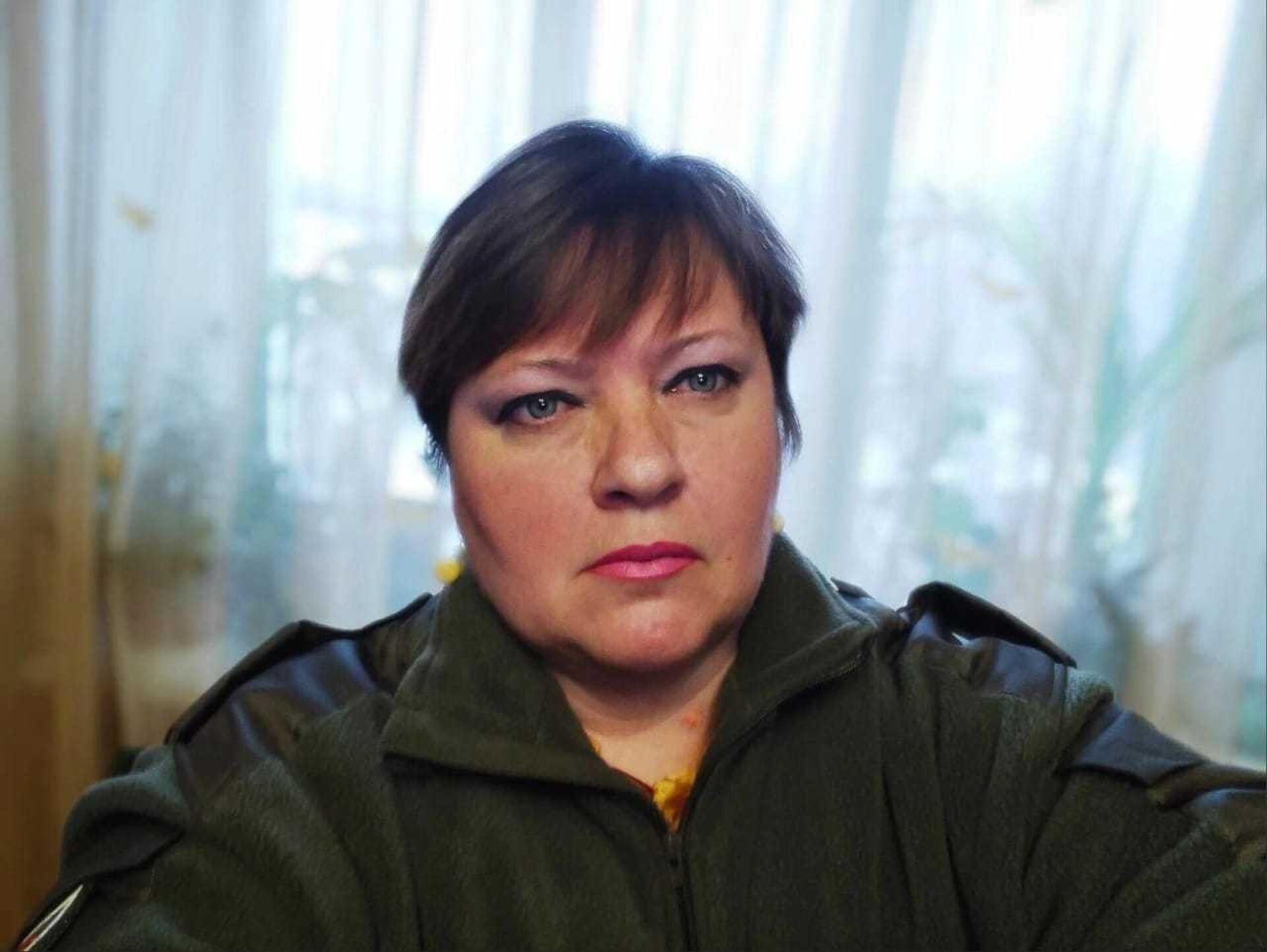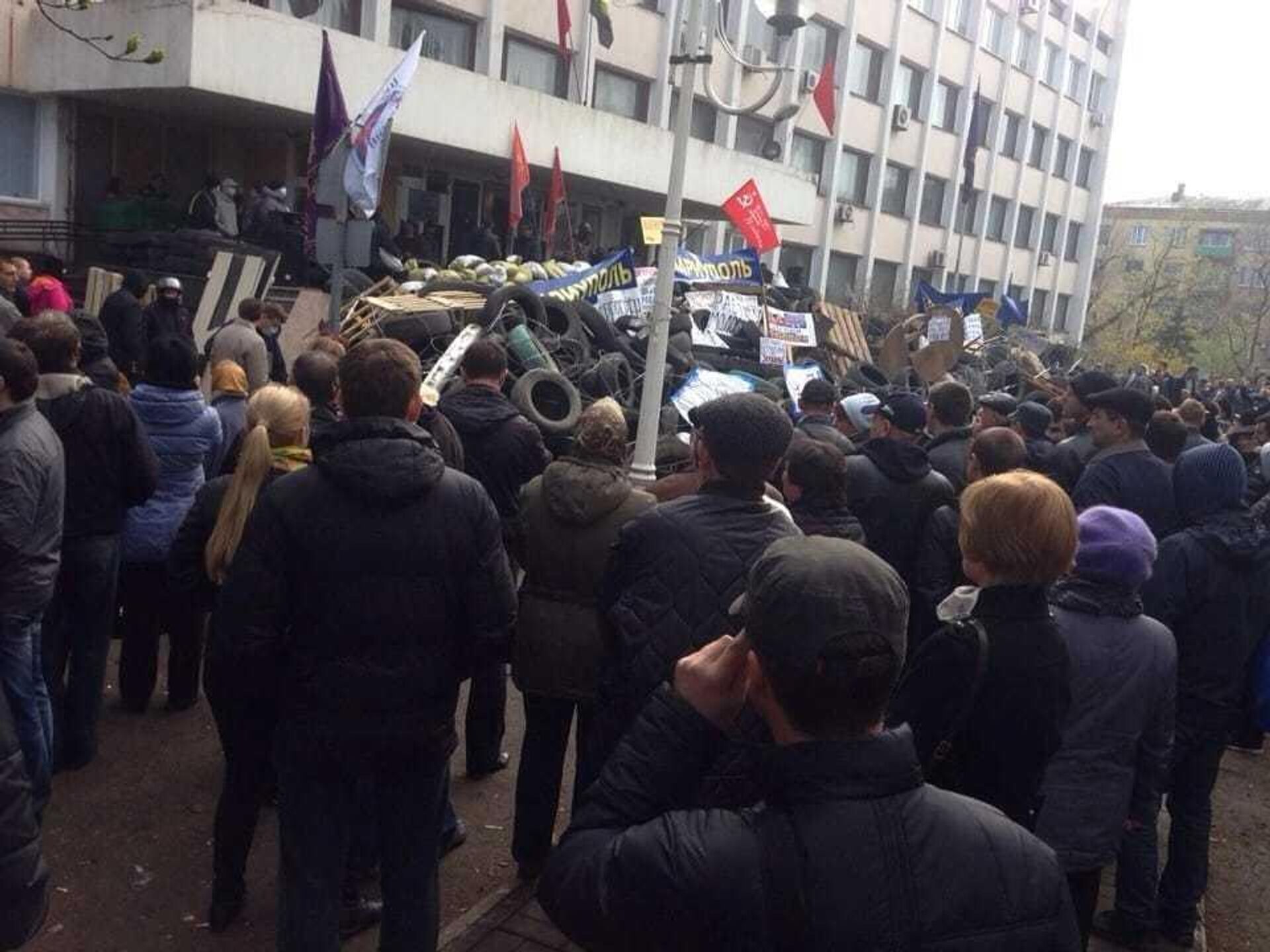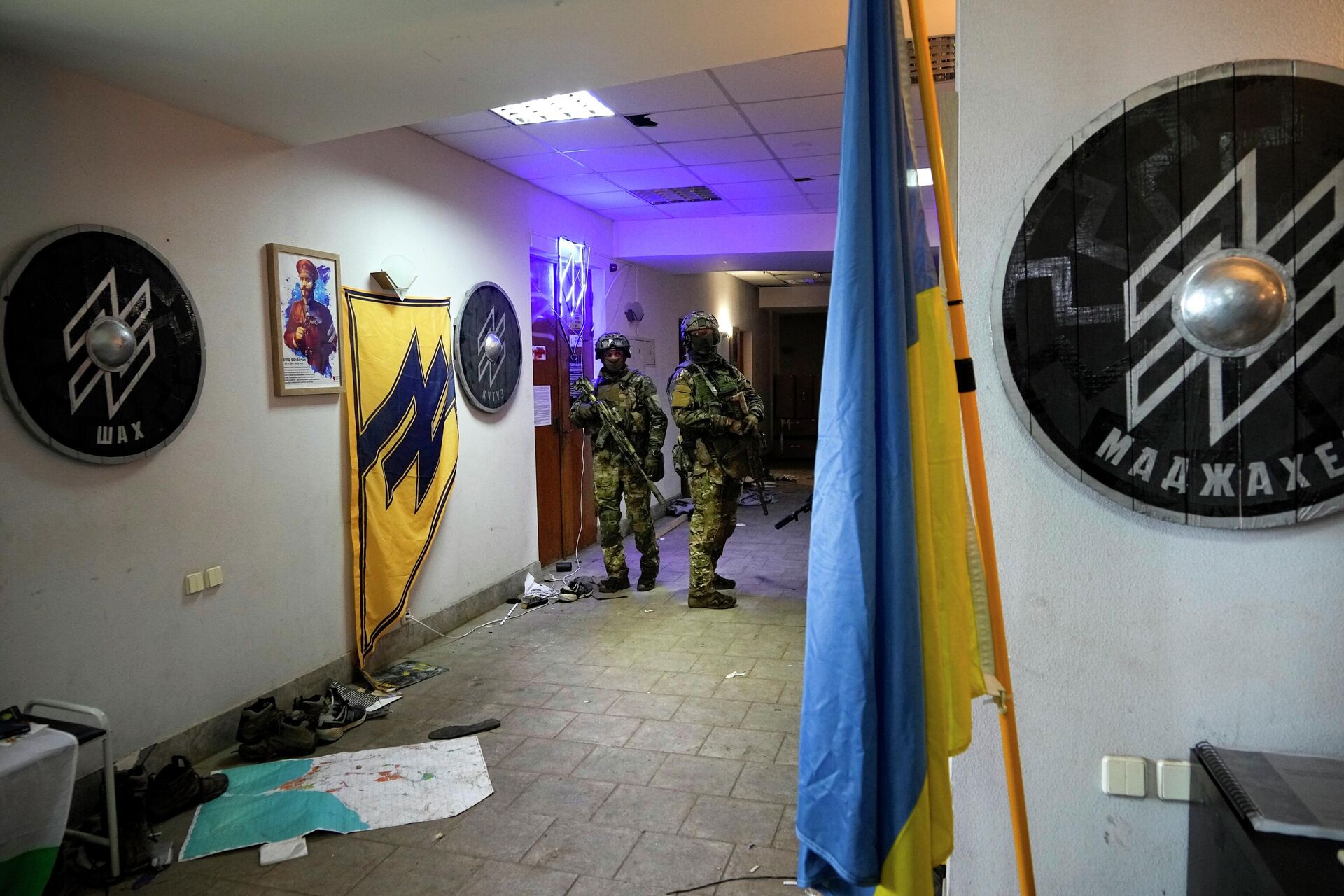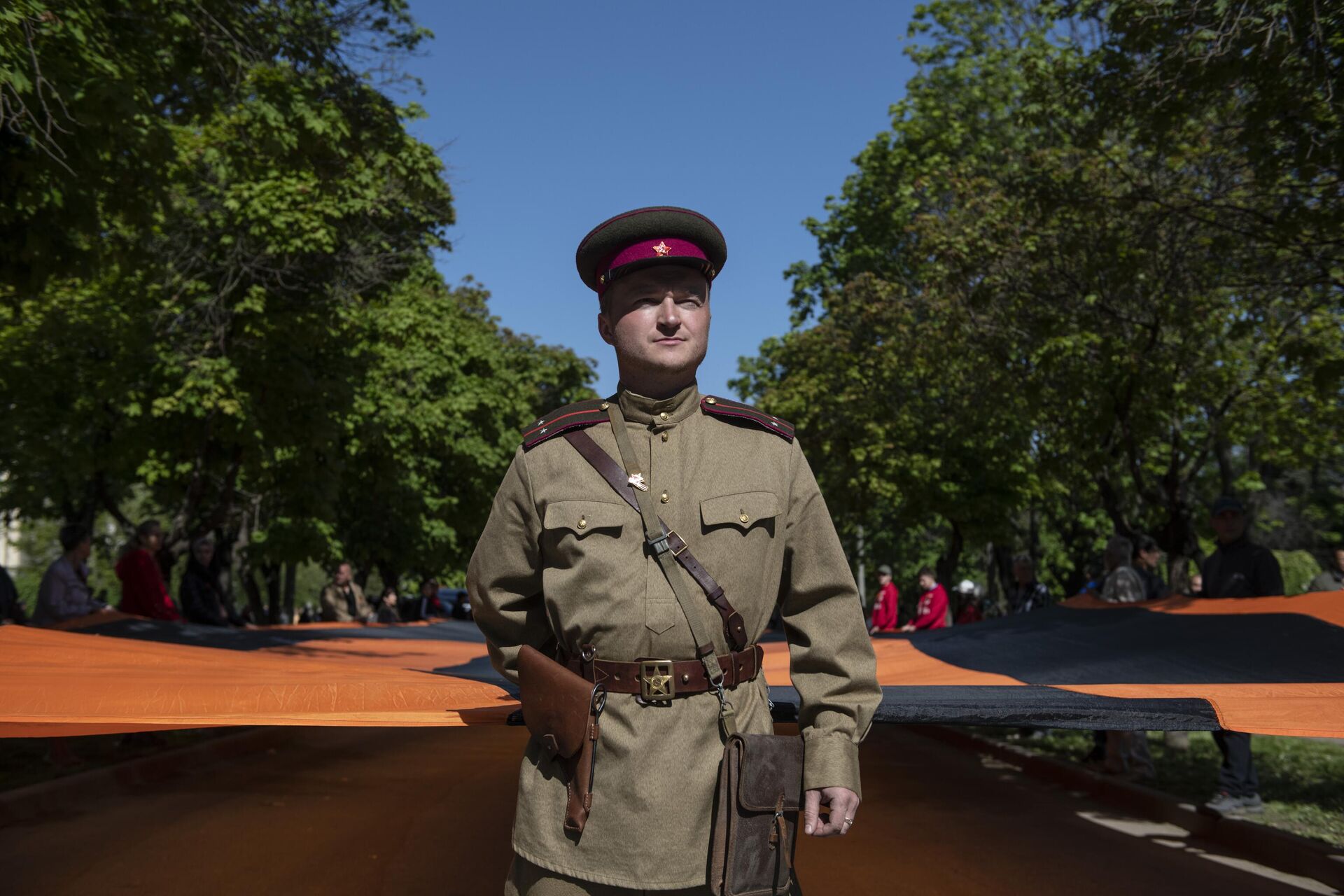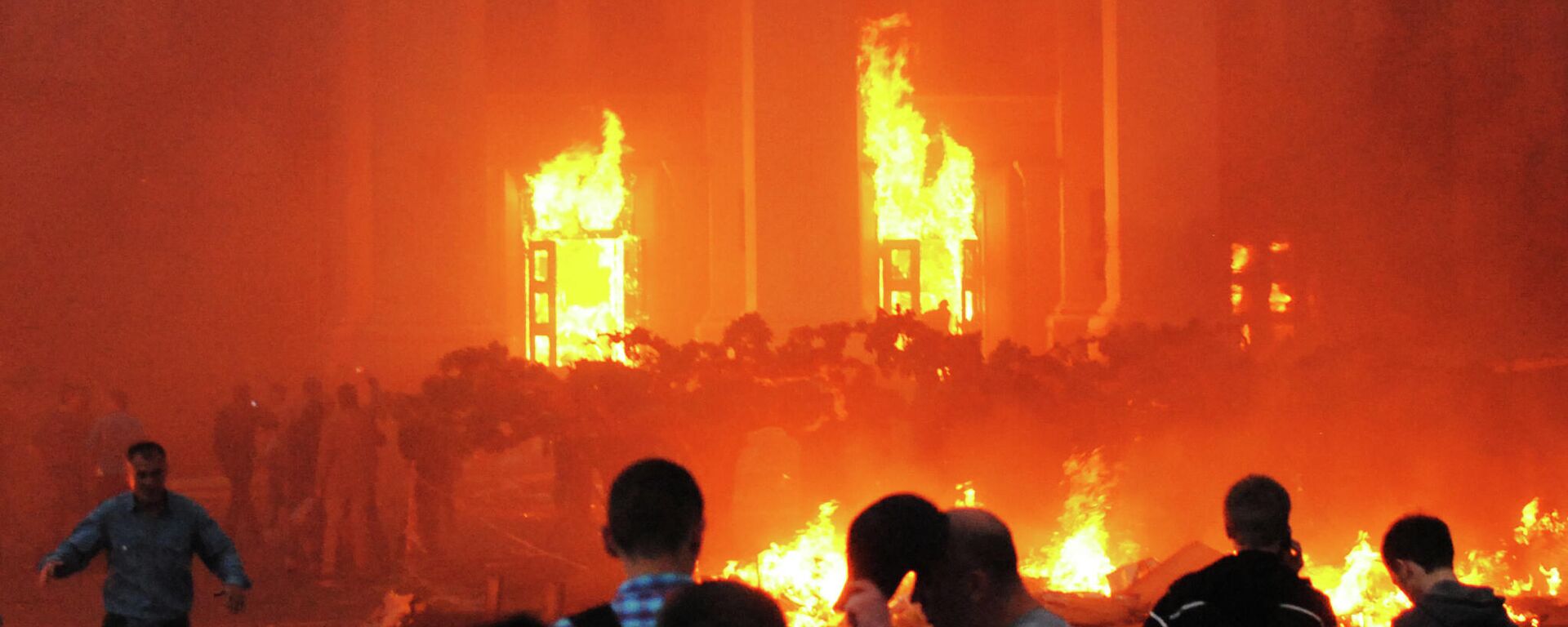https://en.sputniknews.africa/20230509/1059137490.html
'They Fired at Civilians': Mariupol Residents Recall 2014 Victory Day Massacre
'They Fired at Civilians': Mariupol Residents Recall 2014 Victory Day Massacre
Sputnik Africa
Mariupol residents have shared with Sputnik how Ukrainian ultra-nationalists and the military killed and persecuted participants of the Victory Day Parade in the city nine years ago.
2023-05-09T15:03+0200
2023-05-09T15:03+0200
2023-08-03T10:48+0200
opinion
russia
ukraine
victory day
mariupol
2014 ukraine coup
international
https://cdn1.img.sputniknews.africa/img/07e7/05/09/1059137671_0:0:2963:1668_1920x0_80_0_0_68c9002ed5adb486d8a7438721cc4426.jpg
On May 9, 2014, the Kiev regime sent nationalists and the heavily armed military to prevent the citizens of the then-eastern Ukrainian city of Mariupol from holding a Victory Day parade. The move came as part of brazen Russophobic policies pursued by the post-coup Ukrainian authorities and their Western backers following February 2014.On May 9, the peoples of the post-Soviet space are celebrating the USSR's victory over Nazi Germany in 1945. Despite the collapse of the Soviet Union in 1991, the historical memory of the war, which claimed the lives of 27 million people from all national groups of the country, has long served as a strong unifying factor for the inhabitants of post-Soviet Republics.Those, who seized power in Kiev in February 2014 have never concealed their resentment for the holiday given that many of them were the ideological heirs of Nazi collaborators Roman Shukhevych and Stepan Bandera, notorious leaders of the Organization of Ukrainian Nationalists (OUN) and its paramilitary wing the Ukrainian Insurgent Army (UPA).Mariupol Defenders Took Measures to Protect Veterans"I will not start exactly from May 9, but a little earlier, since we knew that there would be some kind of provocation from the nationalist battalions, the Right Sector*, and we were preparing for their attack," said Viktor.Mariupol residents' concerns were justified: just a week earlier, Ukrainian ultra-nationalists and militias burned alive and bludgeoned to death roughly 50 pro-Russia activists in Odessa's Trade Unions House on May 2, 2014, much in the vein of the WW2-era Banderites.Banderites, a common name for OUN-UPA insurgents, were particularly responsible for the execution of nearly 34,000 Jews in Babi Yar, Kiev, in 1941, and massive ethnic cleansings of Poles in Volhynia and Galicia that claimed the lives of at least 88,700 Polish people, including women, children, and the elderly between 1943 and 1945. Ukrainian nationalists slaughtered Jews, Poles, Russians, Roma people, and other ethnic minorities, dubbing them "subhumans." Banderites would heavily mutilate the bodies of their victims in order to dehumanize them and strike terror.The OUN-UPA are notorious for collaborating with Nazi Germany. Remarkably, some participants of the "Maidan Revolution" in Kiev, dressed in black and camouflage, carried shields with the strange numbers 14/88. According to open sources, 14 is code for "white supremacists," and "88" is the encrypted slogan "Heil Hitler!" ("H" is the eighth letter in the Latin alphabet.) Another favorite symbol of Ukrainian nationalists is the Nazi Wolfsangel insignia, proudly worn by the infamous Azov Battalion* until June 2022, when the terrorist entity was rebranded for PR purposes."Starting in the morning [of May 9], we prepared to guard the column of [World War II] veterans," said Olga. "We had such a task, because the day before we received a message that a provocation was being prepared, the execution of a column of veterans in Mariupol on May 9. This message came from our law enforcement officers. The fact is that people from Kiev arrived a day earlier. And the order was given to arrange a bloody provocation, to shoot a column of veterans (…) All decisions were made in Kiev. It was from there that the order came to arrange this bloody provocation."Viktor and Olga took their positions at the Mariupol Drama Theater. They were ready to protect veterans who, together with Allied Forces of the US and UK, fought against Nazism during WW2.Victory Day MassacreThe Victory Day parade kicked off with veterans and other civilians marching across the city.However, at some point they heard shooting in the area of the Mariupol Internal Affairs Directorate.Olga recalled that at that moment, her phone started ringing. It was a boy named Slavik who was calling her. He told Olga that the building had been attacked and that there were wounded people inside. "Please, get us out of here!" the boy pleaded.It turned out that earlier in the day, the Right Sector had arrived at the Mariupol Internal Affairs Directorate prior to the Victory Day event. Right Sector nationalists demanded that Mariupol policemen disperse the WW2 veterans' rally. Mariupol policemen refused to do so; eventually, a verbal skirmish between the nationalist militia and law enforcement officers turned into a shootout."When we approached the Mariupol Internal Affairs Directorate, we saw that there was shooting going on," Viktor continued. "Men in black fired at the police department. The civilians wanted to go there, but they opened fire on them. We took positions at the crossroads and did not let people in, so that they would not come under fire."The Right Sector nationalists did not come alone: they were backed by the Ukrainian military and armored vehicles.Olga recalled that people tried to stop tanks and armored vehicles by standing in front of them. They tried to not let them through. All in vain, tanks crushed the civilians. Olga noted that after the battle near the building of the Internal Affairs Directorate was over, tanks and IFVs drove around the city and shot people right on the streets.Meanwhile, the defenders of Mariupol made an attempt to rescue police officers and civilians trapped in the police department building. They managed to get to the backyard of the building, hooked the grate on the window with a cable, pulled it out, put up a ladder, and let those trapped out. There were wounded among them."I had a first aid kit with dressings, because we were getting ready and took with us a hemostatic, and tourniquets, and bandages. I tried to help the wounded," she continued.But there were too many of them. Dead people were lying on the streets. Blood was everywhere. The city's morgues were overwhelmed on that day.2014 Referendum, Oppression, LiberationThe bloodbath did not stop the citizens of Mariupol from holding a referendum on May 11, 2014. Several-kilometer-long queues of Mariupol residents lined up in front of the polling stations. People came to cast their votes in the referendum by answering the question "Do you support the Act of State Independence of the Donetsk People's Republic?""The events of May 2 [in Odessa], and of May 9 in Mariupol had a very strong influence on the events of May 11. The referendum was held in Mariupol. More than 96% of people came and voted for the independence of the Donetsk People's Republic. The [Kiev regime] failed to intimidate and break the people of Mariupol," Olga recalled.In response to the military actions by the illegitimate Kiev regime, the people of Donbass organized armed resistance.The infamous secret torture prison at Mariupol Airport was called "The Library." It was run by the Azov Battalion and "supervised" by the Security Service of Ukraine (SBU), according to Vasily Prozorov, a former SBU officer. People detained for having links to the DPR or pro-Russian ideas were called "books." After being checked, the prisoners were kept in the refrigerators of the airport restaurant. According to the testimonies of former detainees, Ukrainian nationalists used different torture techniques, including waterboarding, asphyxiation, breaking fingers, etc.Eight years after the Mariupol Victory Day massacre, the city was finally liberated by Donbass and Russian military forces in May 2022.*Right Sector and Azov Battalion are extremist organizations banned in Russia.
https://en.sputniknews.africa/20230502/1058981341.html
russia
ukraine
mariupol
Sputnik Africa
feedback@sputniknews.com
+74956456601
MIA „Rossiya Segodnya“
2023
News
en_EN
Sputnik Africa
feedback@sputniknews.com
+74956456601
MIA „Rossiya Segodnya“
Sputnik Africa
feedback@sputniknews.com
+74956456601
MIA „Rossiya Segodnya“
ukraine, nazi regime of kiev, mariupol tragedy, fascism in ukraine, victory day
ukraine, nazi regime of kiev, mariupol tragedy, fascism in ukraine, victory day
'They Fired at Civilians': Mariupol Residents Recall 2014 Victory Day Massacre
15:03 09.05.2023 (Updated: 10:48 03.08.2023) Having illegally seized power in February 2014, the neo-Nazi Kiev regime banned Russian language and intimidated Russia-leaning Ukrainians in Donbass. Mariupol residents have shared with Sputnik how Ukrainian ultra-nationalists and the military killed and persecuted participants of the Victory Day Parade in the city nine years ago.
On May 9, 2014, the Kiev regime sent nationalists and the heavily armed military to prevent the citizens of the
then-eastern Ukrainian city of Mariupol from holding a Victory Day parade. The move came as
part of brazen Russophobic policies pursued by the post-coup Ukrainian authorities and their Western backers following February 2014.
On May 9, the peoples of the post-Soviet space are celebrating the USSR's victory over Nazi Germany in 1945. Despite the collapse of the Soviet Union in 1991, the historical memory of the war, which claimed the lives of 27 million people from all national groups of the country, has long served as a strong unifying factor for the inhabitants of post-Soviet Republics.
"This is our holiday, the day of the victory of our grandfathers," said Captain Olga Seletskaya, a participant of the events of May 9, 2014 in Mariupol and Donetsk militia veteran. "My grandfather fought in the Great Patriotic War [the term used for the war of liberation fought by the peoples of the USSR against Nazi Germany and its European allies – Sputnik], was a tank commander, top sergeant, went through the whole war, was captured, escaped, and reached Berlin. He did not like to talk about the war. So this day, May 9, for us is a holiday of the great victory over fascism."
Those, who seized power in Kiev in February 2014 have never concealed their resentment for the holiday given that many of them were
the ideological heirs of Nazi collaborators Roman Shukhevych and Stepan Bandera, notorious leaders of the Organization of Ukrainian Nationalists (OUN) and its paramilitary wing the Ukrainian Insurgent Army (UPA).
"My great-grandfather fought in the Great Patriotic War. I grew up on his stories about the war. They knew that this was a sacred holiday for us, and it was necessary for them to spoil it in every possible way," noted Viktor, a participant of the events of May 9, 2014 in Mariupol, Donetsk militia veteran, and serviceman in the Donetsk People's Republic (DPR) forces.
Mariupol Defenders Took Measures to Protect Veterans
"I will not start exactly from May 9, but a little earlier, since we knew that there would be some kind of provocation from the nationalist battalions, the Right Sector*, and we were preparing for their attack," said Viktor.
Mariupol residents' concerns were justified: just a week earlier, Ukrainian ultra-nationalists and militias
burned alive and bludgeoned to death roughly 50 pro-Russia activists in Odessa's Trade Unions House on May 2, 2014, much in the vein of the WW2-era Banderites.
Banderites, a common name for OUN-UPA insurgents, were particularly responsible for the execution of nearly 34,000 Jews in Babi Yar, Kiev, in 1941, and
massive ethnic cleansings of Poles in Volhynia and Galicia that claimed the lives of at least 88,700 Polish people, including women, children, and the elderly between 1943 and 1945. Ukrainian nationalists slaughtered Jews, Poles, Russians, Roma people, and other ethnic minorities, dubbing them "subhumans." Banderites would
heavily mutilate the bodies of their victims in order to dehumanize them and strike terror.
The OUN-UPA are notorious
for collaborating with Nazi Germany. Remarkably, some participants of the "Maidan Revolution" in Kiev, dressed in black and camouflage, carried shields with the strange numbers 14/88. According to open sources, 14 is code for "white supremacists," and "88" is
the encrypted slogan "Heil Hitler!" ("H" is the eighth letter in the Latin alphabet.) Another favorite symbol of Ukrainian nationalists is the Nazi Wolfsangel insignia, proudly worn by the infamous Azov Battalion* until June 2022, when
the terrorist entity was rebranded for PR purposes.
"We had rapid response groups that were distributed around the city, in the trunks we had pipes, bits, in which case, to repel the attack," recalled Viktor. "Each was assigned a certain area in the city. But the main forces were located along Lenin Avenue in Mariupol, where the parade was supposed to take place; along Lenin Avenue there were cars. People were prepared to prevent provocations."
"Starting in the morning [of May 9], we prepared to guard the column of [World War II] veterans," said Olga. "We had such a task, because the day before we received a message that a provocation was being prepared, the execution of a column of veterans in Mariupol on May 9. This message came from our law enforcement officers. The fact is that people from Kiev arrived a day earlier. And the order was given to arrange a bloody provocation, to shoot a column of veterans (…) All decisions were made in Kiev. It was from there that the order came to arrange this bloody provocation."
Viktor and Olga took their positions at the Mariupol Drama Theater. They were ready to protect veterans who, together with Allied Forces of the US and UK,
fought against Nazism during WW2.
The Victory Day parade kicked off with veterans and other civilians marching across the city.
"Everything seemed to be peaceful, everything was fine, it was calm," said Olga. "There were even law enforcement officers who helped guard this column, which advanced along Nakhimov Street in the direction of Leninsky Komsomol Square."
However, at some point they heard shooting in the area of the Mariupol Internal Affairs Directorate.
"The civilians immediately ran in that direction, towards the police department building," Viktor said. "We rushed there with them."
Olga recalled that at that moment, her phone started ringing. It was a boy named Slavik who was calling her. He told Olga that the building had been attacked and that there were wounded people inside. "Please, get us out of here!" the boy pleaded.
It turned out that earlier in the day, the Right Sector had arrived at the Mariupol Internal Affairs Directorate prior to the Victory Day event. Right Sector nationalists demanded that Mariupol policemen
disperse the WW2 veterans' rally. Mariupol policemen refused to do so; eventually, a verbal skirmish between the nationalist militia and law enforcement officers turned into a shootout.
"When we moved from the Leninsky Komsomol Square to help our guys trapped in the building of the Mariupol Internal Affairs Directorate, one group went along Apatova Street, and the second group went around the drama theater. At that moment, [Ukrainian nationalists] opened fire on us. They fired at civilians. They shot in the legs, in the head. A sniper was working. One bullet hit the wall near me, I barely managed to bounce. People fell on the ground in front of my eyes. There was a journalist walking with a camera. My guess, it was a foreign journalist who recorded it all, and he was killed, right in front of me."
"When we approached the Mariupol Internal Affairs Directorate, we saw that there was shooting going on," Viktor continued. "Men in black fired at the police department. The civilians wanted to go there, but they opened fire on them. We took positions at the crossroads and did not let people in, so that they would not come under fire."
The Right Sector nationalists did not come alone: they were backed by the Ukrainian military and armored vehicles.
"Ukrainian heavy equipment appeared in the streets and people in military uniform started to shoot at civilians," said Viktor, adding that many were killed and injured. "When infantry fighting vehicles (IFV), armored personnel carriers arrived at the site, we realized that we could not resist them with the forces that we had: we did not have firearms, we had only a few traumatic pistols. We were mostly prepared for hand-to-hand combat. But when they saw that they had started firing at the police department building with anti-tank grenade launchers, we understood that it was dangerous to go there. We began to pull civilians away from the center where all of this was happening, from the building."
Olga recalled that people tried to stop tanks and armored vehicles by standing in front of them. They tried to not let them through. All in vain,
tanks crushed the civilians. Olga noted that after the battle near the building of the Internal Affairs Directorate was over, tanks and IFVs drove around the city and
shot people right on the streets.
Meanwhile, the defenders of Mariupol made an attempt to rescue police officers and civilians trapped in the police department building. They managed to get to the backyard of the building, hooked the grate on the window with a cable, pulled it out, put up a ladder, and let those trapped out. There were wounded among them.
"And this boy, Slavik, who called me, came out of the building and fell to his knees. He prayed to God. Imagine how much he had endured, he had seen it all, and he was grateful to God that they remained alive," said Olga.
"I had a first aid kit with dressings, because we were getting ready and took with us a hemostatic, and tourniquets, and bandages. I tried to help the wounded," she continued.
But there were too many of them. Dead people were lying on the streets. Blood was everywhere. The city's morgues were overwhelmed on that day.
"This is what they did to us on the Victory Day," Olga said.
2014 Referendum, Oppression, Liberation
The bloodbath did not stop the citizens of Mariupol from holding a referendum on May 11, 2014. Several-kilometer-long queues of Mariupol residents lined up in front of the polling stations. People came to cast their votes in the referendum by answering the question "Do you support the Act of State Independence of the Donetsk People's Republic?"
"The
events of May 2 [in Odessa], and of May 9 in Mariupol had a very strong influence on the events of May 11. The referendum was held in Mariupol. More than 96% of people came and voted for the independence of the Donetsk People's Republic.
The [Kiev regime] failed to intimidate and break the people of Mariupol," Olga recalled.
In response to the military actions by the illegitimate Kiev regime, the people of Donbass organized armed resistance.
"In mid-June [2014], after a referendum, [the Kiev regime] took the city under their control," Olga continued. "And then a mass cleansing began. As of September 2014, 3,500 people had gone missing. One can only guess about their fate, what they did with them. Initially, all the detainees were taken to Mariupol Airport, where people were tortured. The crematorium, which had already been built, but had not yet functioned, began its work just then. It then worked around the clock. People who lived near the airport heard machine gun fire. What could this speak to? That people were shot there. There were mass executions."
The infamous secret torture prison at Mariupol Airport was called "The Library." It was run by the Azov Battalion and "supervised" by the Security Service of Ukraine (SBU), according to Vasily Prozorov, a former SBU officer. People detained for having links to the DPR or pro-Russian ideas were called "books." After being checked, the prisoners were kept in the refrigerators of the airport restaurant. According to the testimonies of former detainees, Ukrainian nationalists
used different torture techniques, including waterboarding, asphyxiation, breaking fingers, etc.
Eight years after the Mariupol Victory Day massacre,
the city was finally liberated by Donbass and Russian military forces in May 2022.
"I want to say one thing, not only to Western readers, but primarily to the residents of Ukraine, who are under the control of the Armed Forces of Ukraine," Viktor said. "We are not at war with them, we are at war against the Kiev regime. They are not our enemies, but the Kiev regime is our enemies. They sold Ukraine out to the US, Great Britain, to the collective West. And ordinary Ukrainians remain our brothers and sisters. They are not our enemies. That's what I want to say."
*Right Sector and Azov Battalion are extremist organizations banned in Russia.

